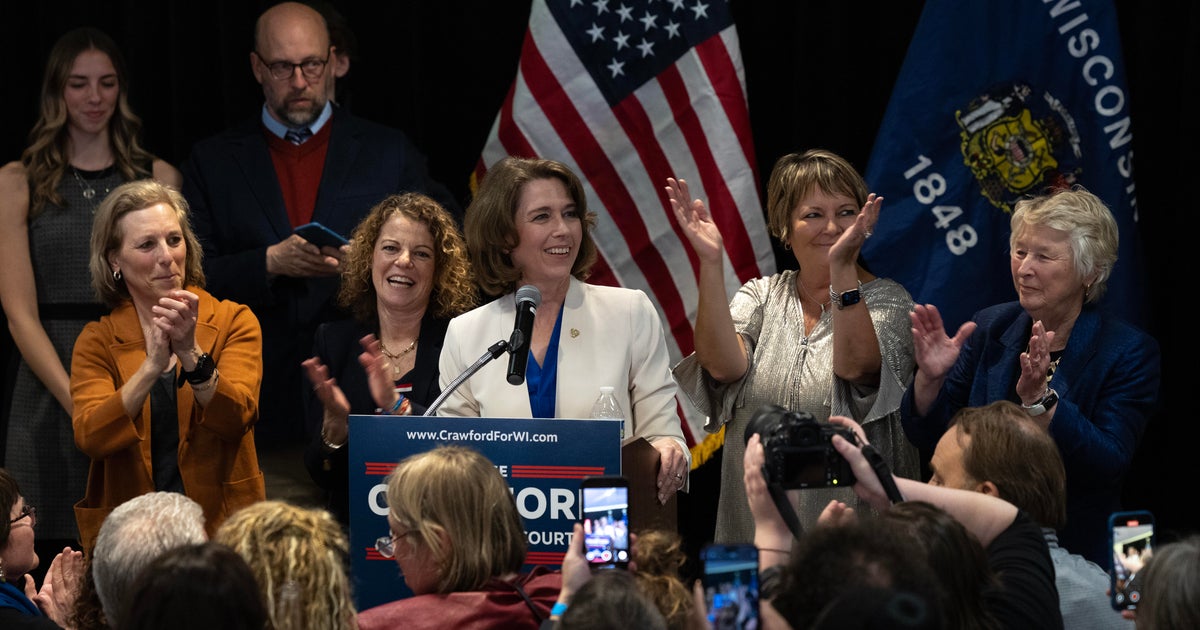A closely watched election for a state supreme court judgeship in Wisconsin gave Democrats a boost Tuesday night, while two special elections in Florida delivered two seats to House Speaker Mike Johnson’s perilously thin GOP majority. Though off-year and special elections attract a much smaller share of voters than presidential elections, the outcomes in both states held insights for Democrats and Republicans for the months ahead. Here are some of the takeaways:
Despite heavy financial backing from Elon Musk and groups tied to him — over $20 million — and an endorsement by President Trump, conservative candidate Brad Schimel lost by a 10-point margin to Susan Crawford, the liberal candidate in the race. Musk’s infusion of millions failed to sway Wisconsin voters in this statewide judicial race, marking a notable political defeat in a battleground state that Trump narrowly flipped in 2024.
Crawford ran primarily against Musk’s involvement in the state — and national Democrats could convert this win into an early game plan heading into the gubernatorial races later this year, and the 2026 midterms.
The race became the most expensive judicial election in U.S. history, with total spending exceeding $90 million and by some projections, reaching $100 million. This unprecedented influx of money — fueled by big-dollar donors on both sides of the race including Elon Musk, George Soros, JB Pritzker and others, underscores the growing nationalization and politicization of state judicial races and raises questions about the influence of outside interests on local races.
In the battle of the billionaire donors waged in this judicial race, there was no bigger loser than Musk, who donated $3 million to the state GOP and groups associated with him spent more than $20 million. The efforts of the world’s richest man also galvanized Democratic voters in Wisconsin to cast their ballot for Crawford according to Wisconsin Democrats.
It will be worth watching how much the outcome impacts the way Musk invests his financial and political capital between now and the 2026 midterms, given the loss he sustained in the Wisconsin race.
With Musk’s help, Republicans won the White House and Senate in the 2024 election, while also maintaining control of the House. In the 2026 midterms, however, the GOP faces challenges in its quest to hold onto and build on its narrow House majority. The interest in Tuesday’s race not just from voters, but also major Democratic donors, suggests a large influx of cash is likely to be invested in both sides at a time when the president’s party is at risk of heavy losses amid pushback by voters.
Turnout was exceptionally high for a spring election and a judicial race, potentially surpassing 2.4 million voters, far exceeding the 2023 state supreme court race, according to CBS News estimates. This surge, coupled with Crawford’s strong performance in key areas like Dane County, indicates a strong mobilization among Democrats and Democratic-leaning voters, driven by concern about the policies of the new Trump administration and opposition to Musk’s involvement.
It also suggests broader interest from the Wisconsin electorate about judicial independence on issues like abortion rights and congressional redistricting.
Crawford’s victory ensured that the Wisconsin Supreme Court maintained its 4-3 liberal majority. This outcome preserves the ideological balance of the state’s highest court that has been in place since 2023. This has already led to significant rulings favoring progressive priorities, such as striking down Republican-drawn legislative maps and addressing voting rights issues.
In speaking with national Democrats after the Wisconsin election results, they say that the win has boosted Democrats nationally as they contend with intraparty squabbling on the direction of the party going into the 2026 midterms. With the Badger State race as a referendum on Musk and Trump policies, the outcome of Tuesday’s election could also serve as a cautionary tale for Republicans as they prepare for the 2025 gubernatorial races and 2026. To many they saw it as a referendum on voter enthusiasm.
Despite Schimel’s loss, President Trump posted on social media to highlight one win for conservatives: Wisconsin voters approved a measure to enshrine the state’s voter ID requirement in the state constitution. The law, which already mandates showing a photo ID at the polls, now holds the added weight of a constitutional amendment.
Republicans Jimmy Patronis and Randy Fine won the 1st and 6th Districts in Florida Tuesday, respectively, maintaining GOP control of the deep-red seats vacated by Matt Gaetz and Michael Waltz. Their victories came with dramatically reduced margins compared to the 2024 general election a few months ago, however. Patronis defeated Gay Valimonti 57-42%, a 15-point margin, and Fine also won his race against Democrat Josh Weil with a 57-42% victory, a sharp drop from Waltz’s 33-point victory in November.
Democrats outperformed expectations in two deep-red Florida districts on Tuesday, fueled by massive fundraising hauls that far surpassed their Republican opponents. Weil raised more than $9 million, while Valimont brought in roughly $6 million — numbers that helped make the races far more competitive than anticipated. Republicans held both seats, but with notably closer margins, underscoring the GOP’s entrenched advantage in these Trump strongholds.
Still, the Democratic contenders notched a symbolic victory when Valimont carried Escambia County — a longtime GOP stronghold in presidential elections — a rare blue dot in the ruby-red district.
Both Patronis and Fine benefited from Mr. Trump’s endorsements and late campaign efforts, including tele-town halls and Truth Social posts, which helped secure their wins. Yet the closer-than-expected races, despite the president’s personal involvement and his own overwhelming victories in these districts — 68% in the 1st District and 65% in the 6th — hint at potential political vulnerabilities in his influence early in his second term, especially when Mr. Trump is not on the ballot. The results bolstered the GOP’s slim House majority, now 220-213, but the tighter margins signal that Mr. Trump’s sway may not be as absolute in off-cycle elections.
Tuesday’s results in Florida line up with CBS News’ political unit’s analysis this week that since Mr. Trump was first elected president in 2017, a seat has flipped in House special elections less than 15% of the time.
contributed to this report.




